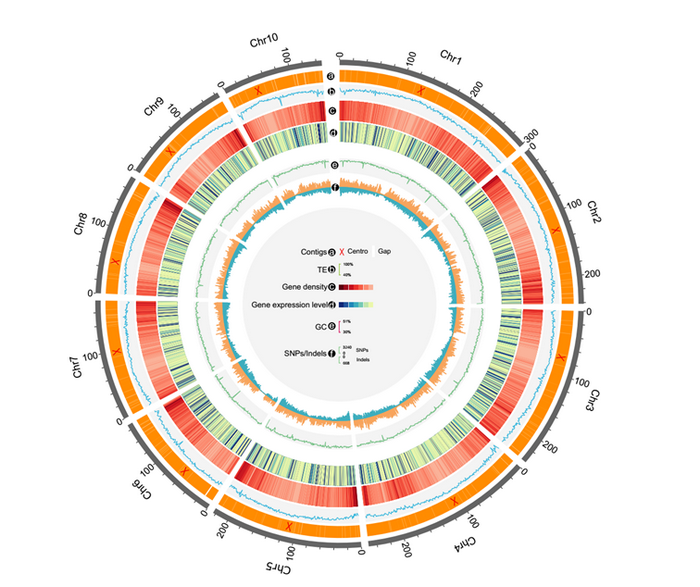On May 31, 2019, Nature Genetics published an online article entitled “Genome assembly of a tropical maize inbred line provides insights into structural variation and crop improvement” by Prof. Yan Jianbing’s team (HZAU) and BGI Genomics. The study has unveiled the highest quality tropical maize reference genome so far, and the first map of maize structural variation. Combined with this information, the key genes affecting the natural variation of grain weight were cloned for the first time.
Why construct tropical maize genome?
Maize is one of the most important crops globally, with an annual production output greater than 1 billion tons. Maize was domesticated about 9,000 years ago in a tropical environment in southwestern Mexico, and then migrated to more temperate regions. Tropical maize germplasm has many excellent traits that temperate maize germplasm does not possess, such as disease and insect resistance and drought tolerance. Maize is also one of the species with the greatest genetic diversity, and the genetic difference between any two maize lines is greater than that between humans and chimpanzees. However, the currently published maize genome materials are all from temperate regions, which cannot fully reveal the genetic diversity of tropical maize as a reference genome. Therefore, the construction of a high quality genome map of tropical maize is of great significance to the genetic study of the dominant resistance traits of tropical maize, and it is prerequisite for fully exploring the genes related to the dominant agronomic traits of maize.
General structure of tropical maize genome map
In this study, a tropical small-grain maize variety (SK) was used as material, applied with Pacbio sequencing technology, Bionano Genomics double digestion optical map, 10X Genomics and second-generation sequencing data, to assemble the maize reference genome with the best quality. The size of the reference genome was 2.32 Gb, and contig N50 was up to 15.78 Mb. 43,271 genes were obtained by annotation, which provided a high quality reference genome and gene set with characterization of genetic diversity of tropical maize lines and mapping of genes related to important agronomic traits by comparative genomics analysis.

Features of the SK genome
What is the function of structural variation map?
Genomic structural variation can directly affect gene expression and individual performance. With the reduction of sequencing cost, structural variation research has gradually become a hot issue in genomics. Based on the newly constructed SK reference genome and the previously published reference genomes of temperate maize B73 and Mo17, the researchers identified 80,164 polymorphic structural variations by applying the deep re-sequencing data of 521 maize inbred lines, of which about 22% were not available by traditional single nucleotide polymorphism (SNP) detection methods. The researchers constructed structural variation map of maize by these variation information, which provided an accurate reference for the further mapping of genes related to important agronomic traits in maize.
Based on this structural variation map, the team found that structural variation was more likely to cause changes in gene expression than SNP. Through the data of ChIA-PET, the researchers concluded that structural variation can not only cause gene expression changes by inserting gene functional regions, but also cause gene expression changes by reconstructing or destroying the three-dimensional interaction of genome.
How are key genes for maize yield cloned?
Maize grain weight directly affects yield and is also one of the key selective traits in maize domestication and improvement. Although many studies have been carried out on the control loci of the trait, the genes affecting the trait have never been located by means of positive genetics.
In this project, the researcher used ZHENG58 and SK to construct a recombinant inbred line population and located a locus (qHKW1) on maize No.1 chromosome that controlled both grain type and grain weight. Then, the gene ZmBAM1d located in the 177Kb genome was identified. It was concluded from gene expression experiments that the gene positively regulated grain weight of maize, and no effect on other agronomic traits was detected in the gene overexpression and knockout experiments, which indicated that the gene had a promising application future in maize quality improvement and could also be used to improve crop yield.
The researchers made an in-depth comparison between the ZmBAM1d gene regions of SK and B73 and found that structural variations directly related to grain weight phenotypes, which indicated that structural variations were the basis of phenotypic differences, and also proved the direct role and future application of the structural variation genome map constructed in agronomic trait-related genes and locating loci.
Dr. Yang Ning and Dr. Liu Jie from HZAU and Dr. Gao Qiang from BGI Genomics are the co-first author. Prof. Yan Jianbing is the corresponding author. Dr. David Jackson, the Chair Professor of Chang Jiang Scholars (HZAU), postdoctoral and postgraduates from Prof. Yan’s research team, and the researchers from BGI Genomics also participated in the research. The collection and analysis of ChIA-PET data was supported by Prof. Li Xingwang and Prof. Li Guoliang’s research teams. The seeds of SK were provided by Prof. Li Jiansheng from the China Agricultural University. This research was supported by the National Natural Science Foundation of China, National Key Research and Development Program of China, and National Key Laboratory of Crop Genetic Improvement, Huazhong Agricultural University.
Link of the article: https://www.nature.com/articles/s41588-019-0427-6
Source: http://news.hzau.edu.cn/2019/0601/54325.shtml
Translated by: Zhao Dongli
Supervised by: Pan Buhan